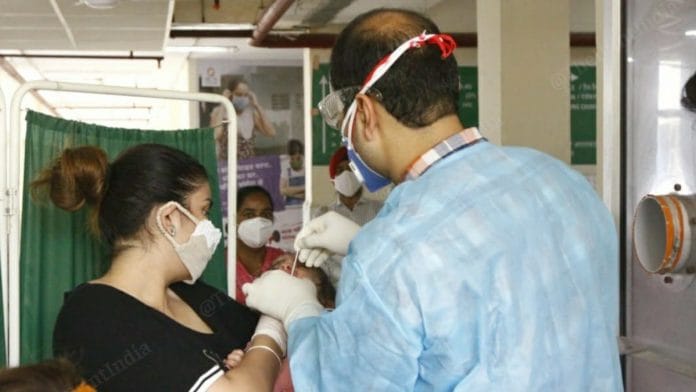Thank you dear subscribers, we are overwhelmed with your response.
Your Turn is a unique section from ThePrint featuring points of view from its subscribers. If you are a subscriber, have a point of view, please send it to us. If not, do subscribe here: https://theprint.in/subscribe/
With over 1.4 billion people, India faces an immense challenge in ensuring quality healthcare for all. Economic disparities and social diversity make this task even more complex. Recognizing this, the government has prioritized healthcare reforms, with the Ayushman Bharat initiative standing out as a major step toward strengthening public health infrastructure.
Launched in 2018, Ayushman Bharat has two key components: Health and Wellness Centres (HWCs) and Pradhan Mantri Jan Arogya Yojana (PMJAY). HWCs aim to enhance rural primary healthcare, while PMJAY provides financial security for secondary and tertiary care to low-income families. However, implementation has varied, with states like Chhattisgarh and Odisha modifying the scheme to suit local needs. While flexibility is necessary, ensuring consistency in quality and access across states remains a challenge.
The Evolution of Public Health in India
India’s healthcare history is rich, shaped by ancient traditions, colonial influences, and modern reforms. Traditional medicine systems like Ayurveda, Siddha, and Unani have played a vital role in health practices. During British rule, Western medicine was institutionalized, leading to hospitals and medical colleges, though access remained limited to elites.
Post-independence, India prioritized public health with primary health centres and immunization programs, tackling maternal and child mortality, communicable diseases, and malnutrition. While progress has been significant, challenges remain, particularly with infectious diseases such as tuberculosis, malaria, and HIV/AIDS, alongside a growing burden of non-communicable diseases (NCDs) like diabetes and heart disease, largely driven by urbanization and lifestyle changes.
Strengthening Healthcare Infrastructure and Workforce
A robust healthcare system requires not only upgraded infrastructure but also a well-trained workforce. Expanding HWCs demands significant investment in recruiting and training community health workers and nurses. Strengthening supply chains for medicines and equipment is equally crucial.
One solution to the uneven distribution of doctors is the creation of an Indian Medical Service (IMS)—a dedicated cadre like the Indian Administrative Service—to deploy medical professionals to underserved areas. Additionally, a State Medical Service could decentralize healthcare administration further, ensuring better access at the local level.
The COVID-19 pandemic exposed gaps in public healthcare, from overburdened district hospitals to shortages in staff and medical supplies. Revitalizing these hospitals and linking them to medical colleges could improve training, enhance service quality, and restore public confidence in the system.
Integrating Healthcare Systems and Leveraging Technology
India’s healthcare landscape is fragmented, with multiple state and central schemes operating in parallel. A more unified approach—possibly a single-payer system—could improve efficiency and accessibility. AI-driven health information services and digital health solutions can further streamline care, particularly in remote areas. Expanding community engagement through Accredited Social Health Activists (ASHA) and local governance mechanisms will also be key to achieving universal health coverage.
Overcoming Persistent Challenges
Healthcare inequalities persist between urban and rural areas, exacerbated by limited infrastructure and shortages of trained professionals. The COVID-19 crisis further exposed vulnerabilities in pandemic preparedness, hospital capacity, and service delivery, highlighting the need for systemic reforms.
A comprehensive approach is necessary:
- Strengthening Primary Healthcare: Enhancing grassroots healthcare can reduce pressure on hospitals and improve early intervention.
- Preventive Healthcare & Public Awareness: Encouraging vaccinations, lifestyle modifications, and regular screenings can help curb rising NCDs.
- Expanding Digital Health and Telemedicine: AI-powered diagnostics, electronic health records, and mobile health services can make healthcare more accessible.
- Public-Private Partnerships (PPPs): Collaboration with the private sector can accelerate infrastructure development and service delivery.
- Sustainable Healthcare Financing: Expanding insurance coverage and adopting innovative financing models can reduce out-of-pocket expenses for patients.
- Improving Governance and Regulation: Strengthening oversight, enforcing quality standards, and accrediting healthcare facilities can ensure better patient outcomes.
A Collaborative Path Forward
Empowering local communities through participatory healthcare governance builds trust and accountability. A healthcare system that combines policy innovation, infrastructure investments, technology integration, and strong stakeholder collaboration can lead India toward universal health coverage and equitable healthcare access.
India’s public health journey reflects both progress and persistent challenges. Moving forward requires political will, sustained investment, and a shared commitment to ensuring health for all. By embracing strategic reforms and fostering inclusivity, India can build a resilient, efficient, and people-centric healthcare system, ensuring the well-being of its vast population.
These pieces are being published as they have been received – they have not been edited/fact-checked by ThePrint


